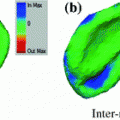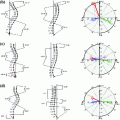require X-ray monitoring every 3–6 months, depending on the rate of progression; (ii) scoliosis between  –
– degrees is treated with bracing; and (iii) scoliosis over 40
degrees is treated with bracing; and (iii) scoliosis over 40 , or if chest deformation causes breathing difficulties, is treated surgically, permanently fusing the vertebrae in a straight position. Scoliosis monitoring continues after surgical treatment as well using regular spine imaging. About 10 % of adolescent scoliosis cases progress to a state when they require therapy.
, or if chest deformation causes breathing difficulties, is treated surgically, permanently fusing the vertebrae in a straight position. Scoliosis monitoring continues after surgical treatment as well using regular spine imaging. About 10 % of adolescent scoliosis cases progress to a state when they require therapy.
Although screening children in the early adolescent age for scoliosis would be necessary for optimal treatment and optimal use of clinical resources, currently affordable screening methods are inaccurate [5]. Therefore, patients may be diagnosed when scoliosis progressed in an advanced stage.
Once diagnosis is confirmed, it is important to frequently monitor all cases to make sure progression is detected early and appropriate therapy is started. However, frequent X-ray imaging in children can lead to increased risk of cancer. Girls who undergo regular spine X-ray, have a nearly twofold risk of breast cancer as adults [6, 7]. Another study found that repeated X-ray exams in childhood significantly contribute to leukemia and prostate cancer [8]. Further studies may be needed to establish accurate estimates of the risks of X-ray, but a safe scoliosis monitoring method would improve the health of this young patient population.
1.2 Scoliosis Monitoring Techniques
Radiation-free scoliosis monitoring methods have been investigated in the past, but none of them have been successful in replacing X-ray in the clinical practice. The optimal method needs to be: free of ionizing radiation, accessible to the patient population, and accurate for therapeutic decision making.
Magnetic resonance imaging (MRI) is a safe and accurate alternative to X-ray. Open MRI machines permit scanning from a standing patient position, making these images suitable for scoliosis angle measurement. Unfortunately, MRI is less accessible than X-ray due to its high cost and the patient has to stand motionless for several minutes while the scanner captures the entire spinal column, which further limits its use for routine monitoring in an adolescent population [9].
Inspection will yield visual signs of scoliosis on the back of the patient. Visual signs of spinal curvatures have been measured using computerized topographic scans of the skin surface using laser scanners and stereo camera technology [10]. However, surface scans are not informative enough to support therapeutic decisions [11].
Ultrasound does not have a large enough field of view to directly visualize spinal curvatures. There have been attempts to use indirect ways of measuring spinal curvatures with ultrasound. A correlation between vertebral rotation and scoliosis angles in untreated patients was discovered [12] but this correlation is unreliable and completely lost in patients receiving therapy [13].
One of the recently emerging imaging modalities is tracked ultrasound: a combination of conventional ultrasound and position tracking technology. With tracked ultrasound it is possible to create a 3D reconstruction from 2D ultrasound images. Position tracking of the ultrasound transducer allows to display the whole spine region in 3D. Experimental results have confirmed that landmarks on reconstructed image volumes could be used to monitor spine curvature angles [14, 15]. Tracked ultrasound appears to be the only alternative to X-ray that fulfills all three requirements: safety, accessibility and accuracy.
A new method for scoliosis measurement has been developed previously, and tested on phantom models [16]. Tracked ultrasound (TUS) has been successfully used in medical imaging and image-guided interventions. In particular, it has been tested in spinal injection navigation [17] and vertebra localization for spine surgery [18].
1.3 Objectives
Our goal is to develop a clinically practical system for scoliosis monitoring. As part of this translational effort we build upon of the proof of concept phantom system proposed by [16] and present a portable TUS system based on a new ultrasound machine and optical tracking. We streamline the workflow of the procedure so it can be easily replicated by other researchers and operated without deep technical background. The workflow is implemented as an open-source module of the 3D Slicer1 application, and can be conveniently installed from the 3D Slicer extension manager (app store). We evaluated the usability of the developed TUS system.
2 Materials and Methods
2.1 System Design
The TUS system has three main components. An optical tracker (Micron Tracker, Claron Technologies Inc., Toronto, Ontario, Canada), a portable ultrasound scanner with USB connection (General Purpose 99–5914 Probe, Interson Corporation, Pleasanton, CA, USA), and a laptop computer (Fig. 1).
Contrary to [16] we use an optical tracker instead of an electromagnetic tracker. Optical trackers can use wireless markers, are generally more accurate and are not affected by metallic or electronic objects in the environment. Sensors used as reference markers are made of paper, which is very cheap and also makes feasible the tracking of multiple reference markers. This can be used for patient motion detection and to be more robust to markers occlusions.
Hardware interfaces are implemented in the PLUS software2 [19]. PLUS implements an abstraction layer over tracker and imaging devices, and provides calibration and synchronization methods for tracked ultrasound. It transmits tracked images to 3D Slicer through the OpenIGTLink protocol [20].
The interface for the portable Interson ultrasound probe was implemented in PLUS. Nevertheless, the system can be used with any of the ultrasound machines and trackers supported by PLUS, which makes reproducibility of the system convenient.


Fig. 1
Schematics of the TUS system (left panel), and the prototype system in use (right panel)
2.2 System Setup
The hardware described in previous section was integrated using the PLUS library. Configuration files to connect different acquisition systems are provided in PLUS website. In particular, sample configuration files used to connect the Interson Probe and the Micron Tracker can be found in the PLUS website.
As with any TUS system, it requires a calibrated probe. If US imaging parameters are not changed, the calibration can be done once and saved in the configuration file. We found that 10 cm depth is adequate for this application.
When the patient comes in, at least one reference marker is attached to his back. This reference marker is used because the patient may move during the acquisition. The assumption is that the relative position between the transverse processes and the reference marker is the same during the whole scanning.
The tracker should be facing a wall where a reference marker must be attached. During the acquisition, the patient will be asked to place in front of the wall. The reason why a marker is attached to the wall is to be able to project the transverse processes positions to the wall. This makes the angle measurements compatible with the traditional procedure done on frontal X-ray radiographies.
2.3 Slicelet Implementation for Spinal Curvature Measurement
We designed and implemented a custom workflow and user interface, called a slicelet, based on the 3D Slicer application platform and its SlicerIGT extension.3 Slicelets are custom user interfaces programmed for the 3D Slicer application that typically support a single clinical workflow without the complexity of the full 3D Slicer user interface. Our slicelet helps in the localization of vertebral transverse processes as landmarks along the spine to measure curvature angles. We build upon [16] and added new features and interfaces to streamline the procedure, reducing the lengthy analysis time.
Stay updated, free articles. Join our Telegram channel

Full access? Get Clinical Tree





